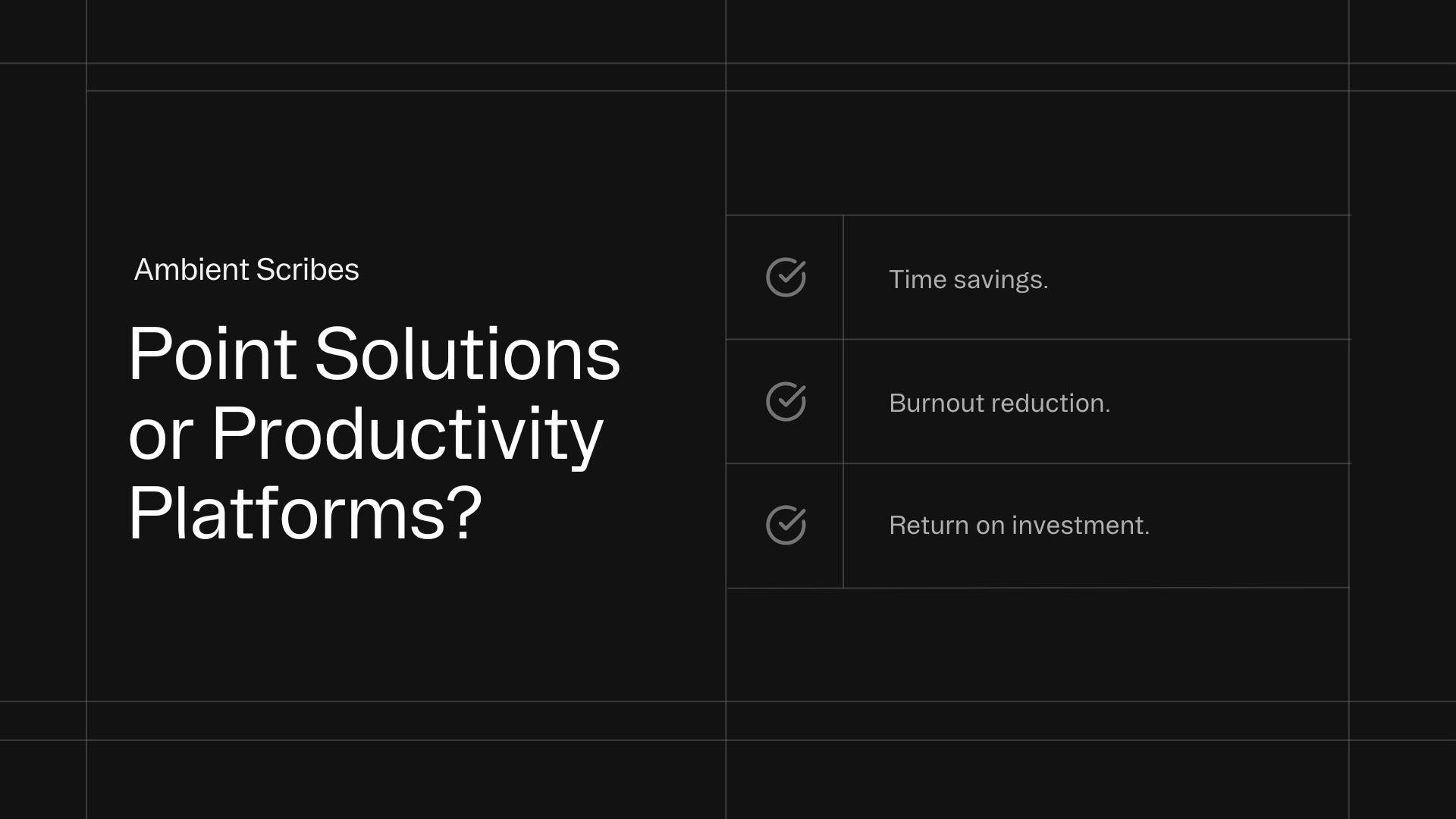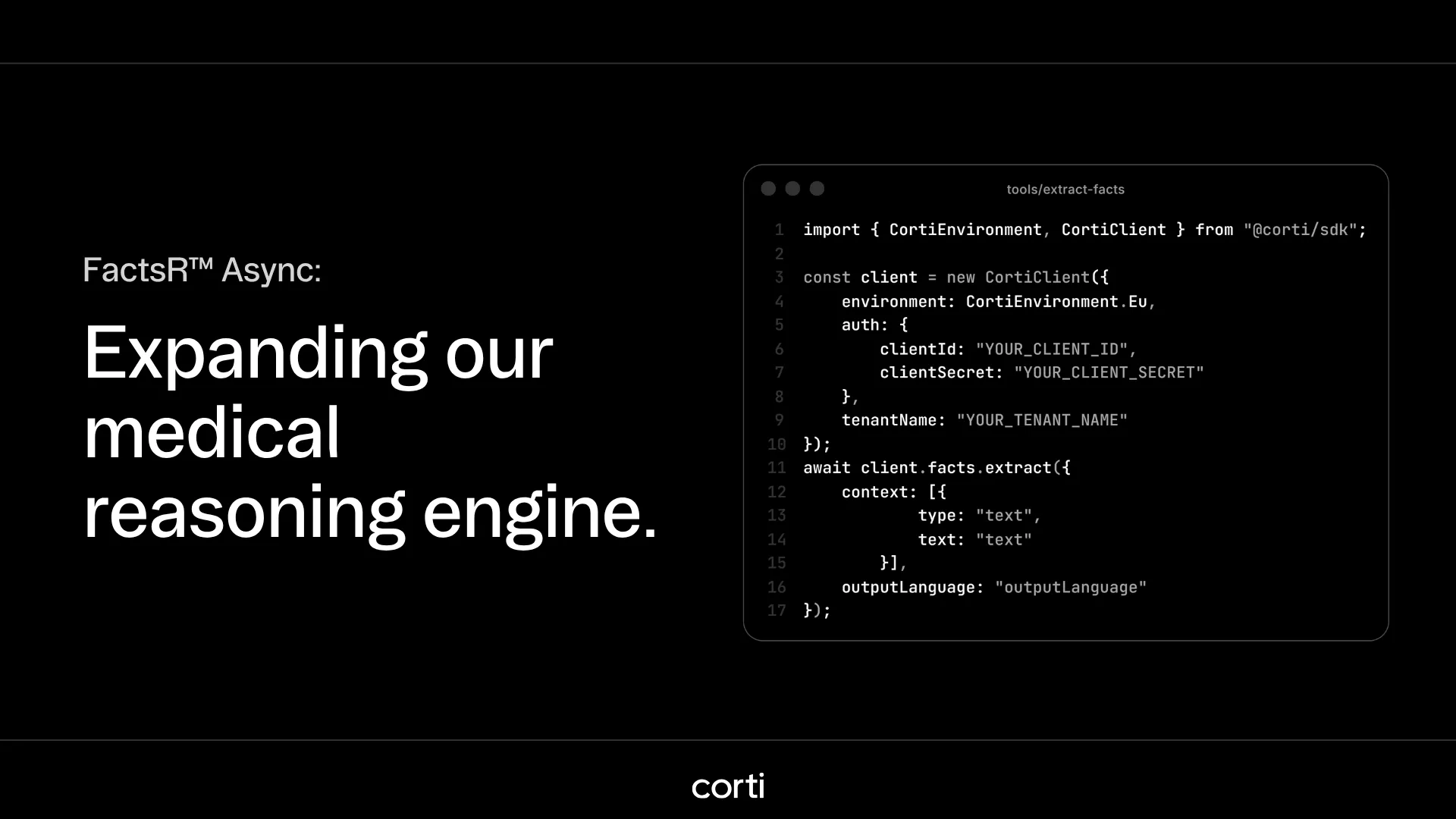8 problems that make healthcare the world’s hardest language
.webp)
Why is healthcare language so hard for AI to understand?
Clinical language is dense, shorthand-heavy, and full of edge cases where a single missed word can flip a diagnosis. General-purpose language models trained on everyday language don't just struggle with this. They fail in ways that put safety at risk.
This post breaks down the eight core reasons healthcare language is uniquely difficult for AI, and what it takes to build systems fluent enough to handle it.
1. Vocabulary size and complexity
Healthcare vocabulary is enormous and constantly evolving. SNOMED CT alone lists more than 360,000 active clinical concepts, far beyond the capacity of general Speech Recognition models. For any healthcare application handling speech input, this quickly becomes a headache.
When models don't understand clinical terminology, transcripts degrade fast. Misspellings, false positives, and wild guesses replace medically critical terms, injecting errors that cascade into downstream workflows.
The problem goes beyond misspelling complex medical terms. Without context, speech recognition models confuse medications, reverse diagnoses, and drop negations. At Corti, we've spent years researching how speech recognition systems handle temporal and linguistic context (Borgholt et al., 2021). Context sensitivity, how models use surrounding words to disambiguate meaning, is critical for accurate transcription. We've built on those findings to design a speech recognition pipeline that understands healthcare conversations the way clinicians do: in context, not in isolation.
Development teams working with generalist speech recognition models often try adding manual dictionaries per specialty. But maintaining those vocabularies is tedious, error-prone, and doesn't scale across clients. Each missed term means QA cycles, bug reports, and clinicians spending time correcting transcripts instead of caring for patients.
Tackling the problem
Our Speech Recognition pipeline is validated on over 150,000 medical terms per language, achieving the highest medical term recall in the market, achieving 40% higher accuracy than leading general-purpose systems.
Building a reliable speech recognition system for healthcare requires more than a large, static vocabulary. It demands adaptability and control. Medical language evolves constantly, with new drugs, procedures, and abbreviations emerging faster than static models can adapt. Without the ability to guide or expand vocabulary, developers face recurring gaps in recognition accuracy and user trust.
Corti’s upcoming /vocabulary endpoint (available Q4 2025) gives teams fine-grained control over the terms used by the speech recognition models. Developers can add or prioritize vocabulary in real time, ensuring that new or specialized language is recognized as soon as it’s needed. This flexibility helps organizations:
- Adapt to emerging medical terminology or local phrasing
- Respond to user feedback and reported misrecognitions
- Tailor vocabularies for specific specialties or institutions
By giving teams the ability to adjust vocabulary directly, Corti helps keep transcription aligned with evolving clinical language and reduces the need for manual maintenance or post-processing work.
2. Unnatural grammar
Clinical speech doesn’t follow natural-language rules. A single note might mix fragments, shorthand, and structured fields:
“ECOG 2. WBC up. Start ceftriaxone 1g IV q24h.”
To a general ASR model, that looks like broken English. The output is messy and hard to read, forcing developers to build extra cleanup steps before passing text to downstream systems like LLMs for summarization tasks or coding engines. Every extra layer adds latency and risk. If the grammar is off, even small misinterpretations (like missing a negation) can cascade into incorrect documentation.
Tackling the problem
Our multi-stage pipeline is designed for clinical grammar. After transcription, a domain-aware language model adjusts word choice to fit medical context (“forty white count” becomes “fourteen white count”), while a punctuation and formatting layer restores readability and structure. A final post-processing stage expands acronyms and standardizes numbers so output looks like a professional note, not raw dictation.
Developers receive clean, structured text directly from the API. No regex scripts or LLM cleanup passes required. That means faster development, fewer bugs, and smoother integration into existing EHR fields or downstream automation.
3. Semantic density
Clinical sentences pack enormous meaning into a few words. A line like
“Afebrile, tolerating PO, drain output 50cc serosanguinous”
This conveys vitals, nutrition, and wound status all at once. General-purpose ASR may capture the words but fails to reflect the structure or relationships behind them. Developers end up with flat text that’s difficult to parse for decision support or structured storage. Extracting usable data requires custom parsers or rule-based scripts that are brittle and costly to maintain.
Tackling the problem
ASR that understands context and doesn't “just transcribe”.
- The language model integration preserves medical phrasing and ensures units, values, and qualifiers align properly.
- Post-processing organizes these elements into structured segments, ready for downstream logic.
- And with optional enrichment steps, developers can transform transcripts into SOAP notes, summaries, or billing codes.
The result is semantically rich text that downstream systems can trust. Developers spend less time cleaning data and more time building features clinicians actually use.
4. Polysemy and ambiguity
In healthcare, words don’t always mean what they seem. A “negative test” is good news, while a “poor prognosis” is bad. Even the word “stable” can mean “unchanged” or “critical but not worsening,” depending on specialty and context.
For developers, these ambiguities become silent errors. A general-purpose model might choose the wrong sense of a word, flipping meaning in ways that break semantic meaning. When context isn’t correctly interpreted, downstream systems from auto-generated summaries to coding engines propagate the mistake. Developers are left adding fragile rules via endless prompt engineering to patch meaning, but those rules will never cover every edge case.
Tackling the problem
Domain-adapted language models that interpret meaning through medical context, not surface-level patterns.
- Models that recognize that “negative” next to “biopsy” is positive, and “positive” next to “blood culture” may indicate infection.
- The contextual LLM refinement stage ensures each phrase is consistent with clinical logic.
Developers no longer need to write custom disambiguation code. The medical-grade ASR pipeline delivers transcripts that carry correct intent, ready for decision support, summarization, or structured storage.
5. A multi-modal language
Healthcare language mixes modalities: numbers, symbols, waveforms, and codes live alongside text. A line like
“CXR shows RUL opacity, WBC 16k, CRP 145, O₂ sat 88%”
This isn’t just language. It’s structured data embedded in narrative.
For developers, this creates friction. General ASR may misplace decimals, drop units, or treat measurements as text strings, forcing post-processing to extract meaningful values. Missed or mis-formatted numbers can break analytics, create coding errors, or confuse clinicians.
Tackling the problem
A post-processing and domain adaptation layer that recognizes and standardizes multimodal elements:
- Converts spoken values (“one four creatinine”) into precise numbers (“1.4”)
- Captures units and symbols (%, mg, mmHg) accurately
- Structures labs, meds, and vitals into consistent formats
This structured output integrates seamlessly into EHRs or downstream pipelines. Developers get ready-to-use data, not raw text, unlocking automation without complex parsing logic.
6. Specialties have “dialects”
Each specialty speaks its own dialect. Oncology notes reference “ECOG,” cardiology uses “EF,” psychiatry writes in narrative scales. General ASR models treat these as unknowns or misspell them entirely.
For developers, the fix has traditionally been fragmented vocabularies, i.e. maintaining manual dictionaries or models per specialty. That adds complexity, multiplies QA effort, and slows releases. Each new customer vertical feels like a rebuild.
Tackling the problem
ASR built exclusively for healthcare, designed to go deep across medical specialties.
- Focused entirely on clinical language, not general-purpose domains like law or cooking
- Trained on diverse medical data to capture the terminology and phrasing used across fields, from dentistry to psychiatry
- Supports collaboration on custom adaptations for teams working with highly specialized or localized vocabularies
The result is a model fluent in the many “dialects” of medicine, giving developers consistent performance across specialties and flexibility to refine further where needed.
7. Localization issues
Healthcare language changes across regions — abbreviations, coding schemes, and even phrasing differ between the US, UK, and Europe. A model trained for American English might fail in a UK-clinic by misinterpreting UK-specific abbreviations.
For builders targeting multiple markets, localization becomes a technical obstacle. Teams juggle separate models, regional rules, and compliance constraints. Data residency laws (like GDPR) further complicate deployment.
Tackling the problem
ASR built for healthcare across regions, with transparent performance and room to grow.
- Each supported language is assigned a performance tier (Base, Enhanced, or Premier) that defines available accuracy, vocabulary depth, and latency
- Premier languages like US and UK English include full medical vocabulary and advanced modeling
- Continuous benchmarking and finetuning ensure progress across all locales
- Teams can run their own evaluations and add regional terms through vocabulary customization
This approach gives developers clarity on current capabilities and confidence to expand into new markets as coverage deepens.
8. Personalization issues
Every clinician develops a personal style: custom abbreviations, preferred phrasing, or shorthand. For developers, this variability causes frustration. Models trained on population-level data miss individual quirks, forcing users to adapt to the system. Over time, this erodes trust and leads to more corrections, lowering adoption.
Tackling the problem
We give developers real-time control over personalization. Through the /vocabulary endpoint, teams can add user-specific terms or bias recognition toward a clinician’s unique phrasing. These updates take effect immediately and feed into global retraining for future improvement.
The result is an experience that feels tailored but scalable. End users see their words recognized correctly, while developers avoid maintaining one-off models per user.
Building for clinical fluency
For developers, these eight problems aren’t theoretical. They surface as burnt cycles, missed deadlines, frustrated users, and technical debt. Corti’s end-to-end ASR pipeline abstracts those challenges into a single, healthcare-tuned platform:
- Accurate on medical vocabulary
- Context-aware and grammar-smart
- Structured, safe, and compliant
- Easy to integrate, bias, and scale
With Corti, teams can build applications that understand the hardest language in the world and turn speech into reliable, actionable data from day one.




%20(3).webp)